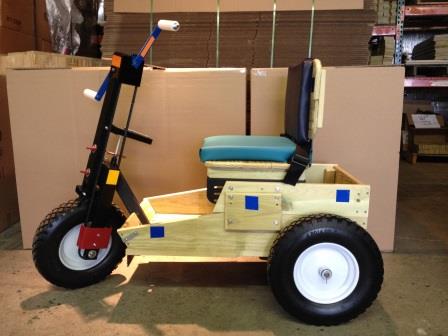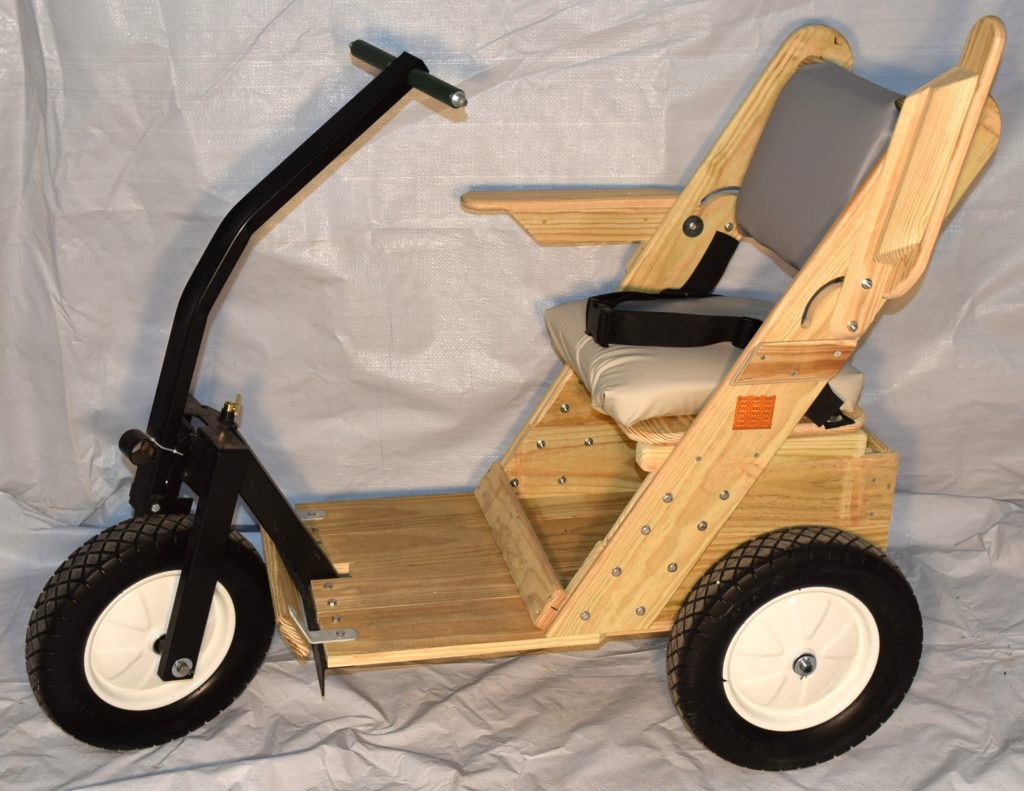About
Mobility Worldwide is a faith-based, volunteer-powered, humanitarian, and world-wide organization. U.S. Affiliate Workshops and Mobility Worldwide operate as tax-exempt 501(c)(3) under the U.S. Internal Revenue Code.
Mobility (Personal Energy Transportation) Beginnings
Mobility Worldwide began in 1994 when Larry Hills, missionary in Zaire (now Congo), Africa, told Reverend Mel West of the great need for three-wheeled, hand-cranked wheelchairs for victims of polio and landmines. Mel contacted Earl Miner, product designer and long-time friend and mission partner, and the process of the prototype design began.
In 1995, When prototype development was ready for field testing, four were shipped to Larry Hills with the instructions to “put these in the worst place you can find, and see if they pass the test.” Larry did, and the Mobility Carts did. Shipments began to Zaire, where Larry had set up a place to receive the frames, put on the wooden beds, and distribute them. See history for the full story.
Mobility Worldwide Philosophy
Mobility Worldwide is not wed to just this particular model of machine. Besides raising funds for building Mobility vehicles, some affiliates collect other used mobility devices such as canes, foldable walkers, crutches, and wheelchairs. Even if they need minor repairs/replacement parts, we receive and send them on to one of our distribution partners, Hope Haven International, in Iowa. They refurbish used mobility devices and distribute along with our Mobility Carts in over 100 countries to date.
Our goal is the Gift of Mobility for all of God’s people in need. We will cooperate and share with anyone working toward that goal. We seek to involve lay persons in the Church as major servants in this mission. We want to work with all groups, religious or secular and seek to provide mobility first for those in greatest need and with least resources.
Mobility Cart Design
Mobility Cart design is controlled and overseen by Mobility Worldwide, and the Mobility Carts are produced at the Affiliate sites. The Mobility Cart has been extensively field tested and is designed to be:
- STURDY, in order to provide services for the rider for many years
- SIMPLE, to be easily maintained in outpost conditions
- LOW-COST, so the donor dollar can serve as many as possible – $300
These requirements have led to the following details of the design:
- Hand-cranked: The hand-cranked model has proven most successful in most field conditions.
- Sturdy tires: The Mobility Cart uses sturdy and low cost wheelbarrow wheels and solid rubber tires.
- Three versions are made: Small & large crank sizes and Pull Mobility Carts for those who do not have upper body strength or coordination. A missionary in Zambia says in his area there are as many in need of this new design, Pull, as the standard crank Mobility Cart.
- Adaptability: The Mobility Cart can be adapted to a wide variety of bed or seat configurations.
- Simple brakes: The Mobility Cart has a front-wheel brake, with a simple parking brake.
Despite this robustness, the Mobility Cart is not an all-terrain vehicle.
It will not go everywhere. Its ability to move is limited to the muscle power of the driver. As the driver uses the vehicle more, he/she gains strength. Other notes are:
- The Mobility Cart moves out at about the speed of a fast walk.
- There are always “trade-offs” in designing any machine. The crank pedals of the Mobility Cart always turn. This gives a needed reverse gear, but when coasting downhill the driver should remove his/her hand from the cranks and steer with the steering tiller/brake handle, slowing the speed by pushing down on the brake handle.
Places of Use
Mobility Worldwide as sent mobility to the following countries to date:
- Zambia: The steel supplies and solid rubber tires for the cart are shipped there via container, and the wooden part (we call this the ‘bed’) is made locally and then distributed. Sometimes we ship the completed cart. At one time, they had 4,400 persons on a waiting list.
These other areas have all received one or more Mobility Carts.
- Afghanistan
- Argentina
- Armenia
- Angola
- Bahamas
- Bangladesh
- Belize
- Benin
- Bolivia
- Bosnia
- Botswana
- Brasil
- Bulgaria
- Burkina Faso
- Burundi
- Cambodia
- Cameroon
- Chad
- China
- Colombia
- Costa Rica
- Cuba
- Democratic Republic of Congo
- Democratic Republic of São Tomé and Príncipe
- Djibouti
- Dominican Republic
- Ecuador
- El Salvador
- Eritrea
- Ethiopia
- Fiji
- Gabon
- Gambia
- Gaza
- Georgia
- Ghana
- Guatemala
- Guinea
- Guinea-Bissau
- Haiti
- Honduras
- India
- Indonesia
- Iraq
- Ivory Coast
- Jamaica
- Jordan
- Kazakhstan
- Kenya
- Kosovo
- Kyrgyzstan
- Laos
- Latvia
- Liberia
- Madagascar
- Malawi
- Mali
- Mauritius
- Mexico
- Micronesia
- Moldova
- Mongolia
- Morocco
- Mozambique
- Myanmar
- Namibia
- Nepal
- Nicaragua
- Niger
- Nigeria
- North Korea
- Pakistan
- Panama
- Papua New Guinea
- Paraguay
- Peru
- Philippines
- Republic of Congo
- Romania
- Russia
- Rwanda
- Samoa
- Senegal
- Sierra Leone
- Somalia
- Sri Lanka
- Republic of South Sudan
- Swaziland
- Syria
- Tajikistan
- Tanzania
- Thailand
- Togo
- Tonga
- Trinidad
- Turkey
- Uzbekistan
- Uganda
- Ukraine
- Uruguay
- Vanuatu
- Vietnam
- West Bank
- Western Sahara
- Zimbabwe



